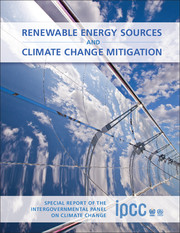 Renewable Energy Sources and Climate Change Mitigation
Renewable Energy Sources and Climate Change Mitigation Book contents
- Frontmatter
- Contents
- Section I
- Section II
- Section III
- Chapter 1 Renewable Energy and Climate Change
- Chapter 2 Bioenergy
- Chapter 3 Direct Solar Energy
- Chapter 4 Geothermal Energy
- Chapter 5 Hydropower
- Chapter 6 Ocean Energy
- Chapter 7 Wind Energy
- Chapter 8 Integration of Renewable Energy into Present and Future Energy Systems
- Chapter 9 Renewable Energy in the Context of Sustainable Development
- Chapter 10 Mitigation Potential and Costs
- Chapter 11 Policy, Financing and Implementation
- Section IV
- Index
- References
Chapter 7 - Wind Energy
Published online by Cambridge University Press: 05 December 2011
- Frontmatter
- Contents
- Section I
- Section II
- Section III
- Chapter 1 Renewable Energy and Climate Change
- Chapter 2 Bioenergy
- Chapter 3 Direct Solar Energy
- Chapter 4 Geothermal Energy
- Chapter 5 Hydropower
- Chapter 6 Ocean Energy
- Chapter 7 Wind Energy
- Chapter 8 Integration of Renewable Energy into Present and Future Energy Systems
- Chapter 9 Renewable Energy in the Context of Sustainable Development
- Chapter 10 Mitigation Potential and Costs
- Chapter 11 Policy, Financing and Implementation
- Section IV
- Index
- References
Summary
Executive Summary
Wind energy offers significant potential for near-term (2020) and long-term (2050) greenhouse gas (GHG) emissions reductions. A number of different wind energy technologies are available across a range of applications, but the primary use of wind energy of relevance to climate change mitigation is to generate electricity from larger, grid-connected wind turbines, deployed either on- or offshore. Focusing on these technologies, the wind power capacity installed by the end of 2009 was capable of meeting roughly 1.8% of worldwide electricity demand, and that contribution could grow to in excess of 20% by 2050 if ambitious efforts are made to reduce GHG emissions and to address the other impediments to increased wind energy deployment. Onshore wind energy is already being deployed at a rapid pace in many countries, and no insurmountable technical barriers exist that preclude increased levels of wind energy penetration into electricity supply systems. Moreover, though average wind speeds vary considerably by location, ample technical potential exists in most regions of the world to enable significant wind energy deployment. In some areas with good wind resources, the cost of wind energy is already competitive with current energy market prices, even without considering relative environmental impacts. Nonetheless, in most regions of the world, policy measures are still required to ensure rapid deployment. Continued advances in on- and offshore wind energy technology are expected, however, further reducing the cost of wind energy and improving wind energy's GHG emissions reduction potential.
- Type
- Chapter
- Information
- Renewable Energy Sources and Climate Change MitigationSpecial Report of the Intergovernmental Panel on Climate Change, pp. 535 - 608Publisher: Cambridge University PressPrint publication year: 2011
References
- 37
- Cited by
